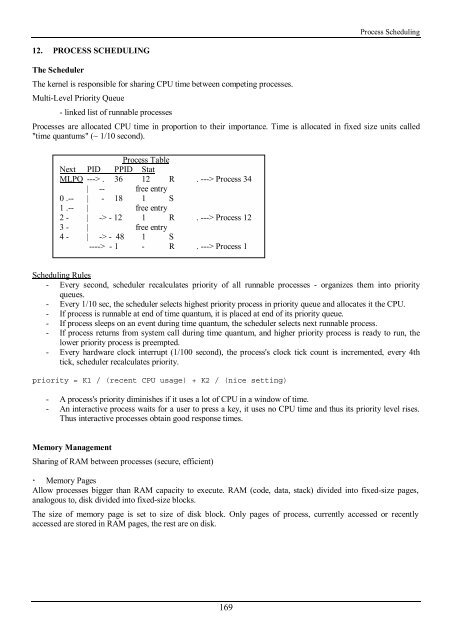You also want an ePaper? Increase the reach of your titles
YUMPU automatically turns print PDFs into web optimized ePapers that Google loves.
Process Scheduling<br />
12. PROCESS SCHEDULING<br />
The Scheduler<br />
The kernel is responsible for sharing CPU time between competing processes.<br />
Multi-Level Priority Queue<br />
- linked list of runnable processes<br />
Processes are allocated CPU time in proportion to <strong>the</strong>ir importance. Time is allocated in fixed size units called<br />
"time quantums" (~ 1/10 second).<br />
Process Table<br />
Next PID PPID Stat<br />
MLPQ ---> . 36 12 R . ---> Process 34<br />
| -- free entry<br />
0 .-- | - 18 1 S<br />
1 .-- | free entry<br />
2 - | -> - 12 1 R . ---> Process 12<br />
3 - | free entry<br />
4 - | -> - 48 1 S<br />
----> - 1 - R . ---> Process 1<br />
Scheduling Rules<br />
- Every second, scheduler recalculates priority of all runnable processes - organizes <strong>the</strong>m into priority<br />
queues.<br />
- Every 1/10 sec, <strong>the</strong> scheduler selects highest priority process in priority queue and allocates it <strong>the</strong> CPU.<br />
- If process is runnable at end of time quantum, it is placed at end of its priority queue.<br />
- If process sleeps on an event during time quantum, <strong>the</strong> scheduler selects next runnable process.<br />
- If process returns from system call during time quantum, and higher priority process is ready to run, <strong>the</strong><br />
lower priority process is preempted.<br />
- Every hardware clock interrupt (1/100 second), <strong>the</strong> process's clock tick count is incremented, every 4th<br />
tick, scheduler recalculates priority.<br />
priority = K1 / (recent CPU usage) + K2 / (nice setting)<br />
- A process's priority diminishes if it uses a lot of CPU in a window of time.<br />
- An interactive process waits for a user to press a key, it uses no CPU time and thus its priority level rises.<br />
Thus interactive processes obtain good response times.<br />
Memory Management<br />
Sharing of RAM between processes (secure, efficient)<br />
! Memory Pages<br />
Allow processes bigger than RAM capacity to execute. RAM (code, data, stack) divided into fixed-size pages,<br />
analogous to, disk divided into fixed-size blocks.<br />
The size of memory page is set to size of disk block. Only pages of process, currently accessed or recently<br />
accessed are stored in RAM pages, <strong>the</strong> rest are on disk.<br />
169
















